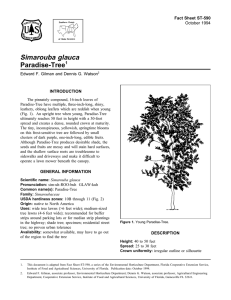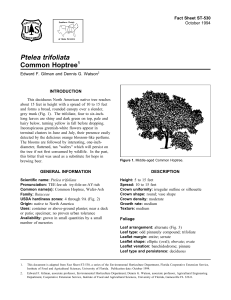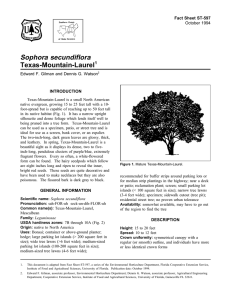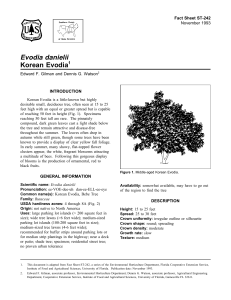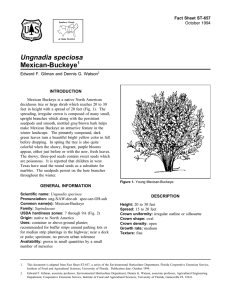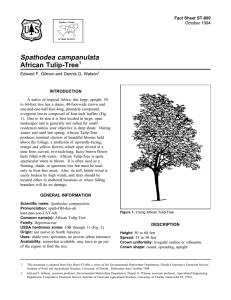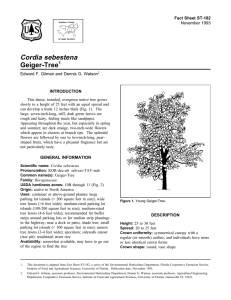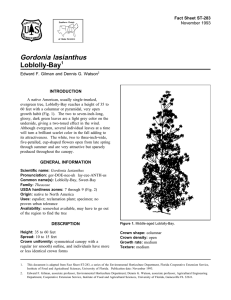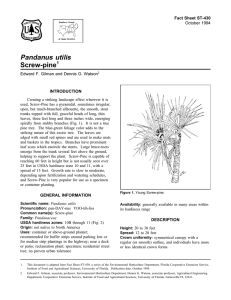Grevillea robusta Silk-Oak Fact Sheet ST-285 1
advertisement
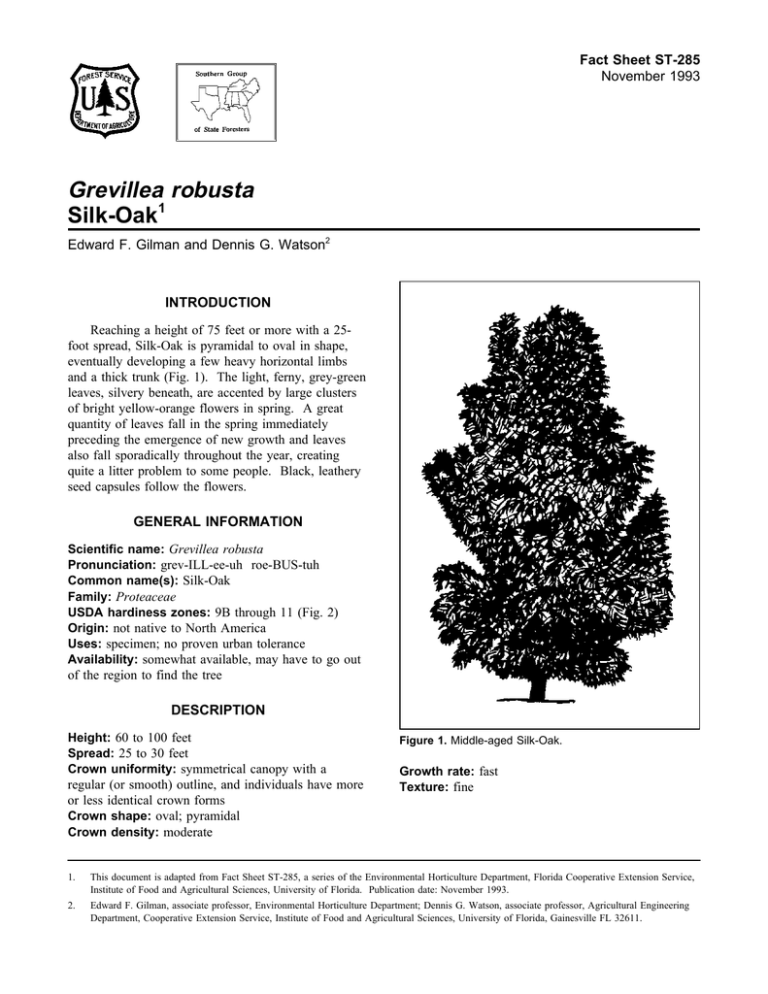
Fact Sheet ST-285 November 1993 Grevillea robusta Silk-Oak1 Edward F. Gilman and Dennis G. Watson2 INTRODUCTION Reaching a height of 75 feet or more with a 25foot spread, Silk-Oak is pyramidal to oval in shape, eventually developing a few heavy horizontal limbs and a thick trunk (Fig. 1). The light, ferny, grey-green leaves, silvery beneath, are accented by large clusters of bright yellow-orange flowers in spring. A great quantity of leaves fall in the spring immediately preceding the emergence of new growth and leaves also fall sporadically throughout the year, creating quite a litter problem to some people. Black, leathery seed capsules follow the flowers. GENERAL INFORMATION Scientific name: Grevillea robusta Pronunciation: grev-ILL-ee-uh roe-BUS-tuh Common name(s): Silk-Oak Family: Proteaceae USDA hardiness zones: 9B through 11 (Fig. 2) Origin: not native to North America Uses: specimen; no proven urban tolerance Availability: somewhat available, may have to go out of the region to find the tree DESCRIPTION Height: 60 to 100 feet Spread: 25 to 30 feet Crown uniformity: symmetrical canopy with a regular (or smooth) outline, and individuals have more or less identical crown forms Crown shape: oval; pyramidal Crown density: moderate Figure 1. Middle-aged Silk-Oak. Growth rate: fast Texture: fine 1. This document is adapted from Fact Sheet ST-285, a series of the Environmental Horticulture Department, Florida Cooperative Extension Service, Institute of Food and Agricultural Sciences, University of Florida. Publication date: November 1993. 2. Edward F. Gilman, associate professor, Environmental Horticulture Department; Dennis G. Watson, associate professor, Agricultural Engineering Department, Cooperative Extension Service, Institute of Food and Agricultural Sciences, University of Florida, Gainesville FL 32611. Grevillea robusta -- Silk-Oak Page 2 Figure 2. Shaded area represents potential planting range. Foliage Trunk and Branches Leaf arrangement: alternate (Fig. 3) Leaf type: odd pinnately compound Leaflet margin: parted; revolute Leaflet shape: lanceolate Leaflet venation: pinnate Leaf type and persistence: evergreen Leaflet blade length: 2 to 4 inches Leaf color: green Fall color: no fall color change Fall characteristic: not showy Trunk/bark/branches: grow mostly upright and will not droop; showy trunk; should be grown with a single leader; no thorns Pruning requirement: needs little pruning to develop a strong structure Breakage: susceptible to breakage either at the crotch due to poor collar formation, or the wood itself is weak and tends to break Current year twig color: brown; gray Current year twig thickness: medium Flower Culture Flower color: orange; yellow Flower characteristics: showy; spring flowering Light requirement: tree grows in full sun Soil tolerances: clay; loam; sand; slightly alkaline; Fruit Drought tolerance: high Aerosol salt tolerance: low acidic; occasionally wet; well-drained Fruit covering: dry or hard Fruit color: black Fruit characteristics: does not attract wildlife; inconspicuous and not showy; fruit, twigs, or foliage cause significant litter Grevillea robusta -- Silk-Oak Page 3 Propagation is by seed. For best results, extract seed from mature, unopened follicles and plant immediately. Pests Caterpillars. Diseases Mushroom root rot on poorly-drained soils. Figure 3. Foliage of Silk-Oak. Other Roots: surface roots are usually not a problem Winter interest: no special winter interest Outstanding tree: not particularly outstanding Invasive potential: little, if any, potential at this time Pest resistance: long-term health usually not affected by pests USE AND MANAGEMENT Silk-Oak works as a specimen in large, open landscapes but probably should not be located near houses due to their large size, messy habit, and the brittleness of the wood as it ages. Tops of trees are known to snap out of the tree in high winds. It is a valuable timber tree in its native Australia, growing to more than 125 feet tall. Quick-growing Silk-Oak requires full sun and sandy, well-drained soils to perform its best, developing mushroom root rot in poorly-drained, wet soils. Silk-Oak thrives in heat and is quite tolerant of drought. It grows extremely well in southern California where it easily reaches 100 feet tall. Tall trees are often hit by lightning in Florida.

